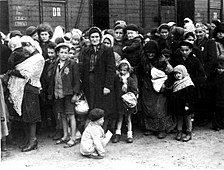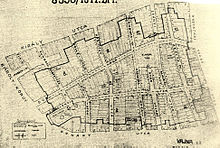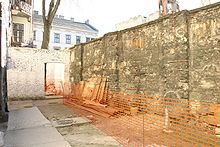
Raoul Gustaf Wallenberg was a Swedish architect, businessman, diplomat, and humanitarian. He saved thousands of Jews in German-occupied Hungary during the Holocaust from German Nazis and Hungarian fascists during the later stages of World War II. While serving as Sweden's special envoy in Budapest between July and December 1944, Wallenberg issued protective passports and sheltered Jews in buildings which he declared as Swedish territory.

The State Protection Authority was the secret police of the People's Republic of Hungary from 1945 to 1956. The ÁVH was conceived as an external appendage of the Soviet Union's KGB in Hungary responsible for supporting the ruling Hungarian Working People's Party and persecuting political criminals. The ÁVH gained a reputation for brutality during a series of purges but was gradually reined in under the government of Imre Nagy, a moderate reformer, after he was appointed Prime Minister of Hungary in 1953. The ÁVH was dissolved by Nagy's revolutionary government during the Hungarian Revolution of 1956 and succeeded by the Ministry of Internal Affairs III.

Giorgio Perlasca was an Italian businessman and former Fascist who, with the collaboration of official diplomats, posed as the Spanish consul-general to Hungary in the winter of 1944, and saved 5,218 Jews from deportation to Nazi extermination camps in eastern Europe. In 1989, Perlasca was designated by Israel as a Righteous Among the Nations.

The Arrow Cross Party was a far-right Hungarian ultranationalist party led by Ferenc Szálasi, which formed a government in Hungary they named the Government of National Unity. They were in power from 15 October 1944 to 28 March 1945. During its short rule, ten to fifteen thousand civilians were murdered outright, including many Jews and Romani, and 80,000 people were deported from Hungary to concentration camps in Austria. After the war, Szálasi and other Arrow Cross leaders were tried as war criminals by Hungarian courts.

Ángel Sanz-Briz was a Spanish diplomat and humanitarian. Sanz - Briz is credited with saving more than 5,200 Jews in German-occupied Hungary from the Holocaust in the later stages of World War II.
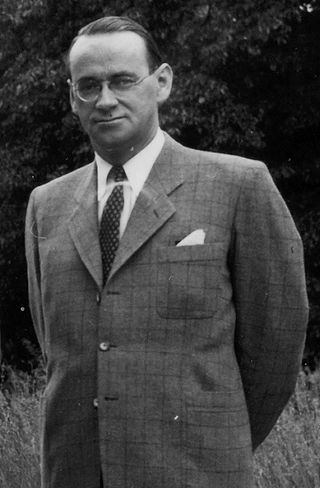
Carl Lutz was a Swiss diplomat. He served as the Swiss Vice-Consul in Budapest, Hungary, from 1942 until the end of World War II. He is credited with saving over 62,000 Jews during the Second World War in a very large rescue operation.

The Dohány Street Synagogue, also known as the Great Synagogue or Tabakgasse Synagogue, is a historical building on Dohány Street in Erzsébetváros, the 7th district of Budapest, Hungary. It is the largest synagogue in Europe, seating 3,000 people and is a centre of Neolog Judaism.

The Shoes on the Danube Bank is a memorial erected on 16 April 2005, in Budapest, Hungary. Conceived by film director Can Togay, he created it on the east bank of the Danube River with sculptor Gyula Pauer to honour the Jews who were massacred by fascist Hungarian militia belonging to the Arrow Cross Party in Budapest during the Second World War. They were ordered to take off their shoes, and were shot at the edge of the water so that their bodies fell into the river and were carried away. The memorial represents their shoes left behind on the bank.
Lars Ernster was a professor of biochemistry, and a member of the Board of the Nobel Foundation.

Pál Szalai also spelled Pál Szalay and later anglicized as Paul Sterling was a high-ranking Hungarian police officer and disillusioned member of the Arrow Cross Party. In 1945, together with Swedish diplomat Raoul Wallenberg, Szalai helped save hundreds of Hungarian Jews in the Budapest ghetto.

Károly Szabó was an employee of the Swedish Embassy in Budapest from 1944 to 1945 when he rescued Hungarian Jews during the Holocaust. He was a supporter of Raoul Wallenberg and had a significant role in making contact with the representatives of the Hungarian police and other state officials. He was arrested without legal proceedings in 1953 in Budapest, in a secret trial.

Friedrich Born was a Swiss delegate of the International Committee of the Red Cross (ICRC) in Budapest between May 1944 and January 1945, when he had to leave Hungary following orders of the occupying Red Army.

Angelo Rotta was an Italian prelate of the Catholic Church. As the Apostolic Nuncio in Budapest at the end of World War II, he was involved in the rescue of the Jews of Budapest from the Nazi Holocaust. He is a significant figure in Catholic resistance to Nazism.

Perlasca – Un eroe Italiano is a 2002 Italian drama, directed by Alberto Negrin, about Giorgio Perlasca, an Italian businessman working in Hungary for his government. After the surrender of Italy to the Allies, he took refuge in the Spanish embassy. Aware of the threat to Jews, he first began to help them find shelter in Spanish safe houses.

José Arturo Castellanos Contreras was a Salvadoran Army colonel and diplomat who, while working as El Salvador's Consul General for Geneva during World War II, and in conjunction with Jewish-Romanian businessman György Mandl, helped save up to 40,000 Central European Jews, most of them from Hungary, from Nazi persecution by providing them with fake Salvadoran citizenship certificates.
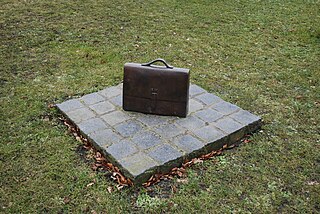
The International Raoul Wallenberg Foundation (IRWF) is a non-governmental organization which researches Holocaust rescuers and advocates for their recognition. The organization developed educational programs for school to promote peace and civil service. Founded by Baruch Tenembaum, it has offices in Buenos Aires, New York, Berlin, Rio de Janeiro and Jerusalem.

Imre Varga was a Hungarian sculptor, painter, designer and graphic artist. He was regarded as one of Hungary's most important living artists, and he has been called one of the "most skilled sculptors in Hungary."
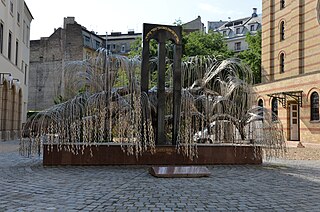
The Raoul Wallenberg Emlékpark in the rear courtyard of the Dohány Street Synagogue holds the Memorial of the Hungarian Jewish Martyrs — at least 400,000 Hungarian Jews were murdered by the Nazis. Made by Imre Varga, it resembles a weeping willow whose leaves bear inscriptions with the names of victims. There is also a memorial to Wallenberg and other Righteous Among the Nations, among them: Swiss Vice-consul Carl Lutz; Ángel Sanz Briz, the Spanish Ambassador in Hungary; Giorgio Perlasca, an Italian man who, with a strategic escamotage, declared himself the Spanish consul, releasing documents of protection and current passports to Jews in Budapest without distinction ; Mons. Angelo Rotta, an Italian Prelate Bishop and Apostolic Nuncio of the State of Vatican City in Budapest, which issued protective sheets, misrepresentations of baptism and Vatican passports to Jews, without distinction of any kind present in Budapest, who saved, with his secretary Mons. Gennaro Verolino tens of thousands of Hungarian Jews during World War II.
Otto Fleischmann was a Hungarian-born Freudian psychoanalyst.
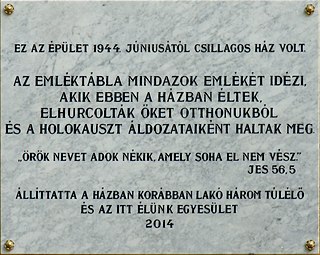
The yellow-star houses were a network of almost 1,950 designated compulsory places of residence for around 220,000 Budapest Jews from 21 June 1944 until late November 1944. Both the houses and their residents were obliged to display the yellow star by Budapest mayoral decree.
